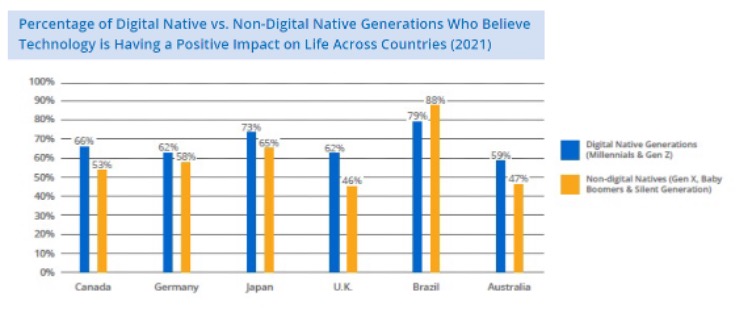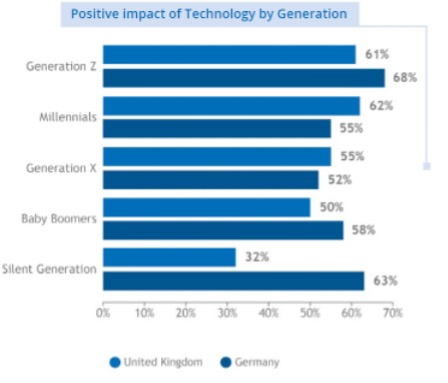Among its many impacts, the COVID-19 pandemic accelerated the adoption of connected products around the world. Smart technology quickly became the primary method many of us used to connect to family and friends, and to work or learn from home – and it performed well.
A Generational Breakdown of Smart Tech Use
It’s no surprise digital natives — Millennials and Gen Z consumers — like connected technology. That’s long been the case. But this year, when asked if connected consumer technologies have made things better or worse, every other generation agrees with their younger counterparts; they say technology is improving their lives. It’s easy to see how social distancing and staying at home mandates played a key role driving not only technology adoption but also positive sentiment around smart tech.
Here’s why: Many people shifted to a work-from-home (WFH) model that was enabled by technology. While Millennials and Gen Z may have worked from home pre-pandemic, Gen X-ers and Baby Boomers were more likely to have experienced WFH for the first time as a result of COVID-19. They got front-row seats to the benefits it provided, including:
- More time at home with family
- Less time commuting
- Lower overhead costs
This trend persisted in other countries (see below table) with the vast majority of Gen X-ers, Baby Boomers and the Silent Generation adopting a positive outlook when it comes to technology’s impact on our lives. The chart below highlights the percentage of respondents who share this positive outlook across the digital native generations (Millennials and Gen Z) and non-digital native generations (Gen X-ers, Baby Boomers and the Silent Generation). It’s worth noting that, in the U.S the most notable uptakes were in Gen Z, Millennials and GenX-ers, who perceived life improvements as a result of technology. Australia’s consumers shared similar sentiments, with 54% of Gen X-ers having a positive outlook and only 45% and 41% of Baby Boomers and the Silent Generation sharing that sentiment respectively.

Millennials and Gen Z continue leading technology adoption, but, for the first time, the majority of all generations in almost every country surveyed, including the UK, now have a positive outlook on connected technology. In the UK and Germany, the positive outlook on technology was strong across the board with the highest positive responses coming from UK Millennials (62%) and German Gen Z (68%) respondents. When looking at the Silent Generation in particular Germany, it shows that ‘internet-connected consumer technologies’ significantly ‘made life better’ with 63% in agreement. This is almost 50% more when, compared to just 32% of UK respondents. For the Baby Boomers generation, the results were much closer by comparison with only 8% difference between the two European countries.

New Connected Purchases During the Pandemic
Across nearly every country surveyed, connected technology use was up. Whether it was working or learning from home or online shopping, consumers spent a lot of time with their technology completing tasks remotely. As consumers who were once slower adopters of technology started using more remote services, they naturally became more willing to purchase equipment to support those services. Globally most people who purchased a connected product said they purchased it for themselves (more than 75%), nearly a quarter (23%) purchased a smart product for a child or parent.
Percent of survey respondents who purchased a new connected product as a result of COVID-19
| Japan | Germany | Canada | Brazil | Australia | UK | U.S. | |
| Overall | 35% | 40% | 33% | 66% | 37% | 44% | 40% |
WHAT THIS TREND MEANS FOR ASSURANT’S CLIENTS:
Greater positive regard for connected technology spells opportunity in three main areas for providers of connected products and services.
- COVID-19 has turned former technophobes into potential customers and advocates for connected technology. This group is an attentive market segment now that they’ve experienced the ease of use and benefits of technology that let them do things like connect to loved ones long-distance, attend telehealth appointments or grocery shop online.
- Older consumers want targeted support. Gen X-er, Baby Boomer and Silent Generation consumers are concerned about replacing broken products, data security and product know-how. To drive adoption and loyalty in these segments, provide onboarding help, tech support and clear explanations around the value of protecting products to avoid costly repairs.
- Flexible tech support is on everyone’s radar. With more people connecting from home now and in the future, flexible tech support options are critical. Everything from self-service digital solutions to assisted advanced diagnostic tech support is the key to winning business from digital consumers across generations.

